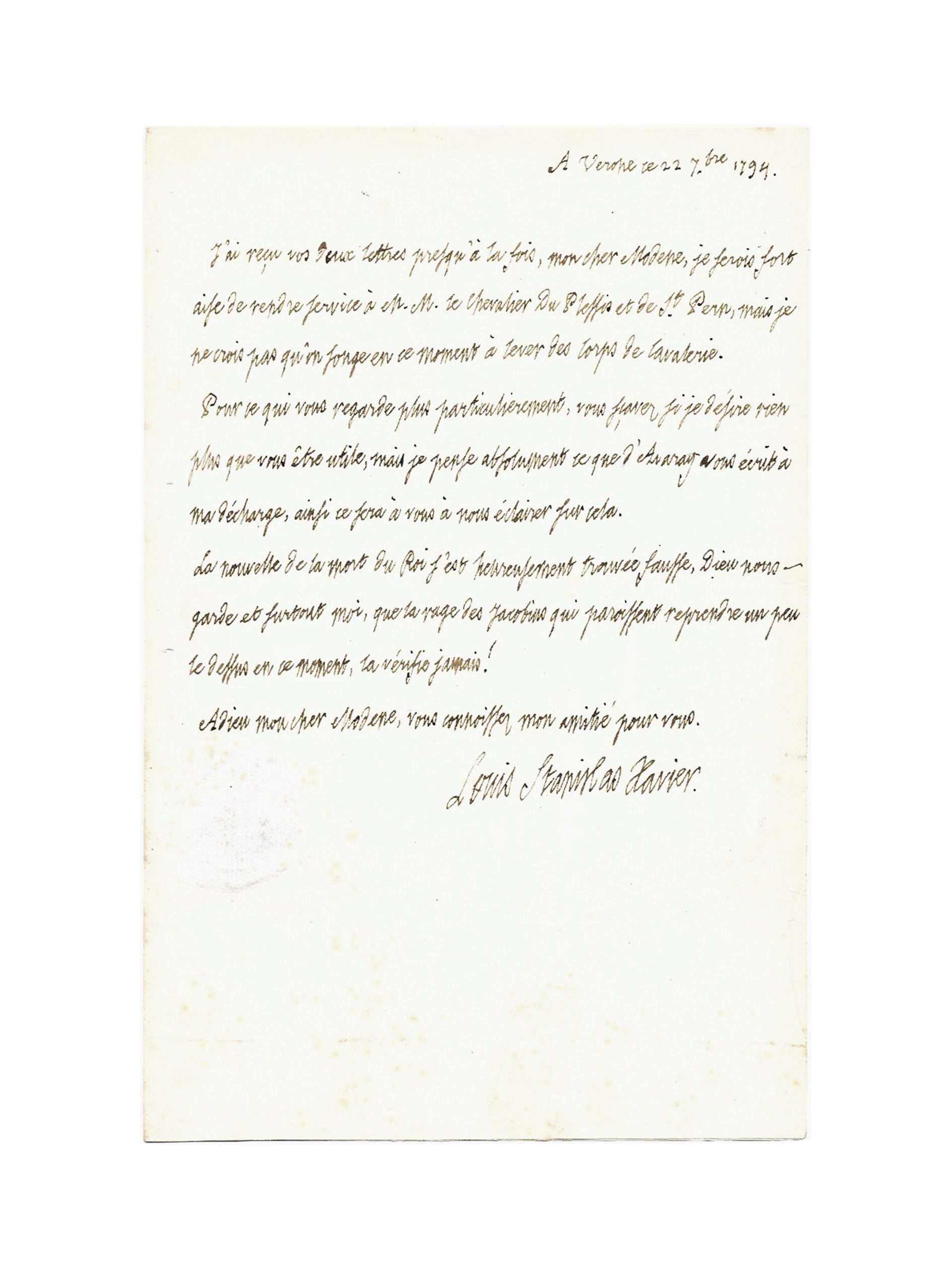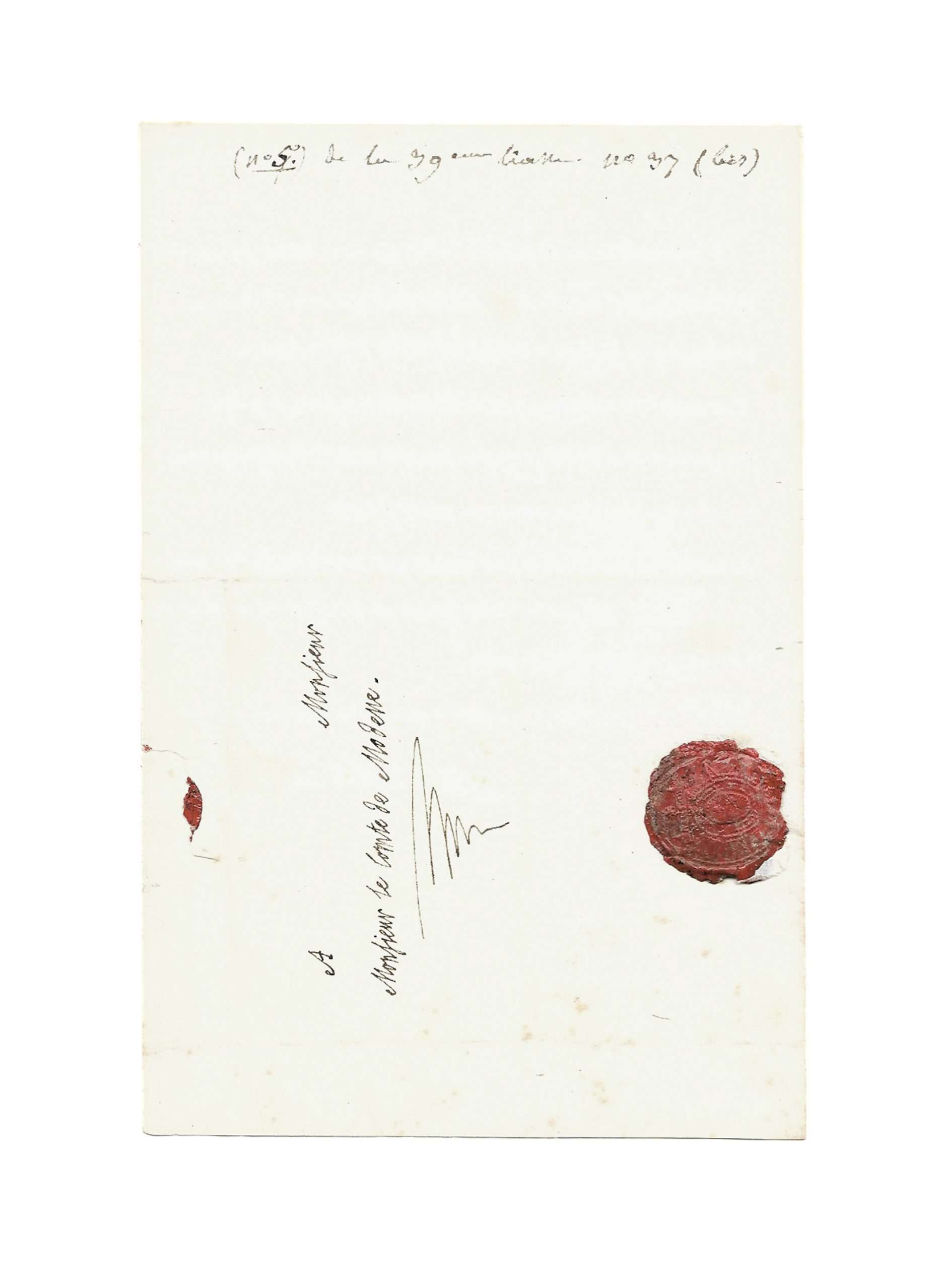LOUIS XVIII, Louis-Stanislas-Xavier de France, (1755-1824)
Autograph letter signed “Louis Stanislas Xavier” to comte de Modène
Verona, 22 September 1794, 3/4 p. in-12, adress on verso
“The rage of the Jacobins…”
Fact sheet
LOUIS XVIII, Louis-Stanislas-Xavier de France, (1755-1824)
Autograph letter signed “Louis Stanislas Xavier” to François Charles de Raimond de Mormoiron, comte de Modène
Verona, 22 September 1794, 3/4 p. in-12, adress on verso, red wax seal to his symbol
Small tear due to original opening, without affecting the text
A few weeks after the fall of Robespierre, the future Louis XVIII announces a false rumor about the death of Louis XVII, then incarcerated at the Temple Tower
“J’ai reçu vos deux lettres presqu’à la fois, mon cher Modène, je serois fort aise de rendre service à M.M. le chevalier Du Plessis et de St-Pern [les officiers de vacalerie Jacques-Auguste Hays Du Plessis et Jean-Louis-Marie-Bertrand de Saint-Pern], mais je ne crois pas qu’on songe en ce moment à lever des corps de cavalerie.
Pour ce qui vous regarde plus particulièrement, vous sçavez si je désire rien de plus que vous être utile, mais je pense absolument ce que d’Avaray [Antoine-Louis-François de Béziade d’Avaray, ami et proche serviteur du futur Louis XVIII qui le ferait duc] vous écrit à ma décharge, ainsi ce serait à vous à nous éclairer sur cela.
La nouvelle de la mort du roi s’est heureusement trouvée fausse, Dieu nous garde et surtout moi que la rage des Jacobins, qui paroissent reprendre un peu le dessus en ce moment, la vérifie jamais !
Adieu, mon cher Modène, vous connoissez mon amitié pour vous.
Louis Stanislas Xavier”
An unwavering prince during exile
The future king had voluntarily left France on 20 June 1791 and had reached Mons on Austrian territory on the day of his brother’s arrest in Varennes. Thus began this long wandering which occupied a third of his life: Deprived of his rights in France, he nevertheless proclaimed himself regent on January 28, 1793 after the execution of his brother Louis XVI, then king on June 24, 1795 after the death of his nephew Louis XVII. His fate was not assured, however, and he had to relocate rather frequently, at the whim of chance and expulsions: After Mons, he stayed in Brussels, Koblenz, Hamm, Verona, Riegel, Blankenburg, Mittau, Warsaw, Blankenfeld, again Mitau, then England from 1807, first at Godfiled Hall, then at Hartwell House.
The tragic fate of the young Louis XVII
Louis-Charles was incarcerated with the rest of the royal family at the Temple Tower after the day of August 10, 1792. He was then abducted from his mother by an order of the Comité de Salut Public of 1 July 1793 and to be placed in the care of the shoemaker Antoine Simon, the designated “teacher”, who could barely write. Locked up on the second floor, the aim was to make him an ordinary little citizen and make him forget his royal condition. After Simon’s departure in January 1794, Louis-Charles was locked incommunicado in a dark room, without hygiene or relief, for six months until 28 July 1794. His food was served through a counter and few people talk to him or visit him. This living condition lead to a rapid deterioration of his health. After the fall of Robespierre, the Comité de Salut Public appointed Laurent, a member of the revolutionary committee of the Temple section. Louis-Charles’s fate improved relatively but he was plagued by tuberculosis. He eventually died on June 8, 1975, at the age of 10, in his cell, isolated from all.
Close friend of the future Louis XVIII, François Charles de Raimond de Mormoiron, Earl of Modena (1734-1799), of a family of very old Provençal nobility, served first as french ambassador to Germany and Sweden, before becoming an honorary gentleman of Monsieur, future Louis XVIII. During the Revolution he left France along with him, but was unable to follow up due to shaky health, and settled in Bayreuth.



